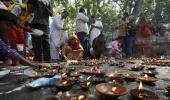
Jammu and Kashmir has come under Governor's rule on seven occasions before in the last four decades and an eighth spell looks imminent with the collapse of the People’s Democratic Party-Bharatiya Janata Party alliance on Tuesday.
Also, if such a scenario emerges with prospects of a new government unlikely it will be for the fourth time that the state will be placed under central rule during N N Vohra's tenure as Governor.
Vohra, a former civil servant, became the Governor on June 25, 2008.
The BJP pulled out of its alliance with the PDP, saying it has become impossible to continue in the government in view of the growing radicalism and terrorism in the state.
Incidentally, late PDP chief Mufti Mohammad Sayeed, the father of incumbent chief minister Mehbooba Mufti and her predecessor, was an important player in the political developments of the state that led to the imposition of central rule on the previous seven occasions.
Mufti Sayeed's death was the cause for the last promulgation of the Governor's rule on January 8, 2016 after allies -- PDP and BJP-- deferred the government formation process till the end of the four-day mourning period.
Invoking Section 92 of the Constitution of Jammu and Kashmir, Vohra promulgated Governor's rule after approval by President Pranab Mukherjee. It was the seventh time Governor's rule was promulgated in the state since Independence, the first being in March 1977.
The central rule came to an end after Mehbooba Mufti was sworn in as the chief minister on April 4, 2016.
Governor's rule was imposed for the first time on March 26, 1977 during the tenure of Governor L K Jha after state Congress -- then headed by Sayeed -- withdrew support to the minority government of Sheikh Mohammad Abdullah of National Conference.
Sheikh had come to the power following an accord with then prime minister Indira Gandhi in 1975.
The Governor's rule lasted for 105 days and ended as the National Conference founder returned to power in the assembly polls.
Governor's rule was imposed for the second time in March 1986 after state Congress -- again headed by Sayeed -- withdrew support to the minority Government of Ghulam Mohammad Shah.
Shah became the Chief Minister after he led a rebellion with National Conference against his brother-in-law and then incumbent Chief Minister Farooq Abdullah in 1984.
This 246-day spell ended after Farooq Abdullah entered into an accord of his own with the then prime minister Rajiv Gandhi.
The third time Governor's rule was imposed in January 1990 when Farooq Abdullah resigned as the chief minister over the appointment of Jagmohan as the Governor following eruption of militancy in the state.
Sayeed was the Union home minister at that time and had brushed aside Farooq Abdullah's opposition to Jagmohan's appointment.
This was the longest spell of Governor's Rule -- six years and 264 days -- which ended in October 1996 after National Conference returned to power in assembly elections held after a gap of nine-and-a-half years.
Six years later, Governor's rule had to be imposed in the state for the fourth time in October 2002 after caretaker Chief Minister Farooq Abdullah refused to continue in the office in the wake of his party's defeat in the assembly elections that year.
The 2002 assembly polls threw up a hung assembly with no party in a position to form a government on its own.
Sayeed, whose regional PDP had won 16 seats, negotiated an alliance with the Congress and dozen-odd independents to form the government, ending the 15-day direct Central rule on March 1, when Sayeed was sworn in as the chief minister.
It was the shortest spell of Governor's rule -- 15 days -- as the PDP and Congress with support of 12 independents formed a government on November 2.
Governor's rule was imposed in the state for the fifth time for 174 days after the PDP withdrew support to Ghulam Nabi Azad-led Congress-PDP coalition government in 2008.
The PDP withdrew support to the government on June 28, 2008 following widespread protests during the Amarnath land row agitation that pitted Hindu-dominated Jammu region against the Muslim-majority Kashmir valley.
Azad was to seek a vote of confidence in the Legislative Assembly on July 7 but chose to resign instead.
The central rule came to an end on January 5, 2009 after NC leader Omar Abdullah was sworn in as the youngest chief minister of the state.
It was for the first time that Governor's rule was imposed during the tenure of Vohra.
The Governor's rule was imposed in the state for the sixth time after the assembly election results on December 23, 2014 threw up a hung assembly with no party or combination of parties able to stake claim for government formation and Omar Abdullah, the caretaker chief minister, asking to be relieved from the duties with immediate effect on January 7.
The central rule ended after the PDP and the BJP stitched an alliance paving the way for the return of Mufti Sayeed as chief minister on March 1, 2015.
When Governor's rule was imposed for the seventh time in 2016 and the third during Vohra's tenure, Omar Abdullah had said imposition of Governor's rule during Vohra's tenure ‘must be a record in itself’.









